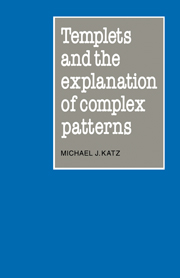Book contents
- Frontmatter
- Contents
- Prologue
- Introduction
- 1 Scientific abstractions
- 2 The nature of explanation
- 3 Configurational explanations
- 4 Templeting
- 5 Self-assembly
- 6 Rules for configurational explanations
- 7 Simple, complex and random
- 8 Reductionism
- Appendix: A pattern theoretic formalization
- Quotation index
- Subject index
6 - Rules for configurational explanations
Published online by Cambridge University Press: 26 March 2010
- Frontmatter
- Contents
- Prologue
- Introduction
- 1 Scientific abstractions
- 2 The nature of explanation
- 3 Configurational explanations
- 4 Templeting
- 5 Self-assembly
- 6 Rules for configurational explanations
- 7 Simple, complex and random
- 8 Reductionism
- Appendix: A pattern theoretic formalization
- Quotation index
- Subject index
Summary
Will Strunk loved the clear, the brief, the bold, and his book is clear, brief, bold. … He scorned the vague, the tame, the colorless, the irresolute. He felt that it was worse to be irresolute than to be wrong. I remember a day in class when he leaned far forward, in his characteristic pose – the pose of a man about to impart a secret – and croaked, ‘If you don't know how to pronounce a word, say it loud! If you don't know how to pronounce a word, say it loud!’ This comical piece of advice struck me as sound at the time, and I still respect it. Why compound ignorance with inaudibility? Why run and hide?
[E.B. White (1979) The Elements Of Style by William Strunk Jr Macmillan, NY, p. xvi.]The power of configurational explanations lies in their explicit separation of the precursor elements and the templets. To use them to best advantage, I suggest the following rules (which presume some consistent philosophical assumptions about inference, such as the set of five postulates proposed by Russell [R.E. Egner & L.E. Denonn (1961) ‘Non-demonstrative inference’ The Basic Writings Of Bertrand Russell Simon & Schuster, NY, pp. 655–66]):
Define the topology of the pattern
Choose a substantive pattern
For a configurational explanation to be predictive, the pattern that it explains should be coherent and relatively permanent. When a pattern is fragmented or ephemeral, formulating configurational explanations can be an empty exercise.
- Type
- Chapter
- Information
- Templets and the Explanation of Complex Patterns , pp. 68 - 71Publisher: Cambridge University PressPrint publication year: 1986



